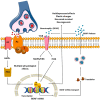Neuroplasticity and Mechanisms of Action of Acute and Chronic Treatment with Antidepressants in Preclinical Studies
- PMID: 39767650
- PMCID: PMC11727250
- DOI: 10.3390/biomedicines12122744
Neuroplasticity and Mechanisms of Action of Acute and Chronic Treatment with Antidepressants in Preclinical Studies
Abstract
Pharmacotherapy for depression includes drugs such as monoamine oxidase inhibitors (MAOIs), tricyclic antidepressants (TCAs), selective serotonin reuptake inhibitors (SSRIs), noradrenaline (NA) and serotonin (5-HT) reuptake inhibitors (NaSSAs), and atypical antidepressants; these drugs exert differentially beneficial effects on symptoms of depression after acute and chronic treatment in animal models. Said effects are established through neuroplastic mechanisms involving changes in neurogenesis and synaptogenesis as result of the activation of intracellular signaling pathways associated with neurochemical and behavioral changes. Antidepressants increase the synaptic availability of monoamines (monoaminergic hypothesis) such as 5-HT, NA, and gamma-aminobutyric acid (GABA) by inhibiting their reuptake or degradation and activating intracellular signaling pathways such as the responsive element binding protein (cAMP-CREB) cascade, which regulates the expression of genes related to neuroplasticity and neurogenesis, such as brain-derived neurotrophic factor (BDNF), in various brain structures implicated in depression. The aim of this review is to analyze the mechanisms of action of different antidepressants and to compare the effects of acute and chronic treatment on neuroplasticity in animal models of depression. A thorough search was conducted in PubMed, Scopus, and Web of Science, focusing on studies since 1996 with keywords like antidepressants, acute and chronic treatment, neuroplasticity, and experimental depression. Studies included had to investigate antidepressant effects experimentally, with full-text access, while excluding those that did not. Data extraction focused on study design, findings, and relevance to understanding treatment differences. Only high-quality, peer-reviewed studies were considered to ensure a comprehensive synthesis of current knowledge.
Keywords: acute and chronic treatment; antidepressants; depression; mechanisms of action; neuroplasticity; neurotrophic factors.
Conflict of interest statement
The authors declare that they have no conflicts of interest.
Figures


Similar articles
-
Monoamine neurocircuitry in depression and strategies for new treatments.Prog Neuropsychopharmacol Biol Psychiatry. 2013 Aug 1;45:54-63. doi: 10.1016/j.pnpbp.2013.04.009. Epub 2013 Apr 19. Prog Neuropsychopharmacol Biol Psychiatry. 2013. PMID: 23602950 Review.
-
Statins and Antidepressants: A Comprehensive Review and Clinical Outlook of the Risks and Benefits of Co-prescription (2022).Cureus. 2022 Dec 8;14(12):e32331. doi: 10.7759/cureus.32331. eCollection 2022 Dec. Cureus. 2022. PMID: 36632257 Free PMC article. Review.
-
[Mechanism of action of antidepressants and therapeutic perspectives].Therapie. 2002 Jul-Aug;57(4):385-96. Therapie. 2002. PMID: 12422559 Review. French.
-
Single-action versus dual-action antidepressants.Prim Care Companion J Clin Psychiatry. 2004;6(Suppl 1):7-11. Prim Care Companion J Clin Psychiatry. 2004. PMID: 16001091 Free PMC article.
-
Behavioral and serotonergic consequences of decreasing or increasing hippocampus brain-derived neurotrophic factor protein levels in mice.Neuropharmacology. 2008 Nov;55(6):1006-14. doi: 10.1016/j.neuropharm.2008.08.001. Epub 2008 Aug 12. Neuropharmacology. 2008. PMID: 18761360 Review.
Cited by
-
Shared Mechanisms in Dementia and Depression: The Modulatory Role of Physical Exercise.J Neurochem. 2025 Aug;169(8):e70185. doi: 10.1111/jnc.70185. J Neurochem. 2025. PMID: 40757845 Free PMC article. Review.
References
Publication types
LinkOut - more resources
Full Text Sources

